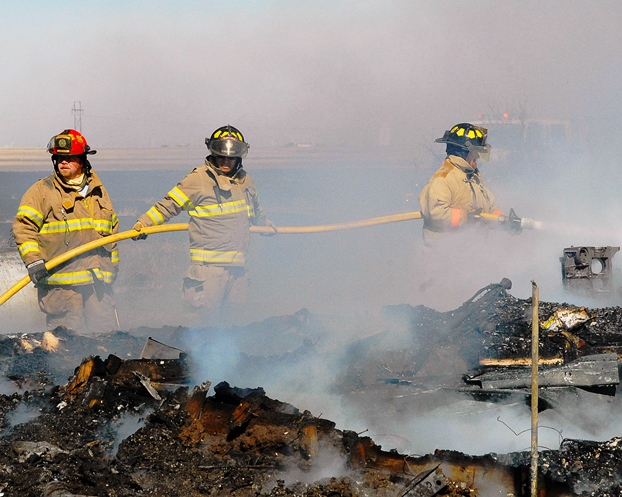Pantex Blog
Panhandle Area Firefighting Brings Response from Pantex

The winds across the Texas Panhandle region are just about as famous as they are hazardous; especially for first responders battling area fires. Such was the case recently, when both volunteer and full time fire fighters joined forces to battle a blaze just a few miles from the Pantex plant, with emergency personnel from Potter County, Groom, Panhandle, and Pantex joining forces in response.
At risk: a house and its neighboring structures along with the potential hazard of a propane tank in the path of the flames. The winds whipped them up and the call for an emergency response went out. Luckily, within a very short time, the fire was out and there were no injuries reported.
Pantex maintains Memorandums of Understanding with the surrounding counties adjacent to the site and when requested, will render aid. Pantex fire and ambulance crews are on standby 24 hours a day, poised to respond to any plant emergencies and to assist surrounding municipalities through their mutual aid agreement.
For the Pantex fire department and its crew, this call was another chance to not only hone their firefighting skills, but even more, an opportunity to help out neighbors in distress. Pantex Fire Chief Mike Brock knows the importance of neighbors helping neighbors.
“All of our services hinge around caring for people. When someone calls for emergency medical or fire service it is likely one of their worst days. Because of our location and the services we offer, many times we can provide the closest emergency response to incidents near the plant As Spring begins, we will start to have wild fire season and having these agreements is key to providing enough resources to address the large fast moving wild fires in our area,” he said.
The Pantex fire department is certified through the Texas Commission on Fire Protection (TCFP) and regularly trains to ensure it meets or exceeds TCFP continuing education requirements. Members of the department maintain certifications so they are ready to respond to any emergency that arises, whether on-site or in a neighboring community.
“Our department provides emergency response for fire, emergency medical, rescue and hazardous materials. In order to satisfy the continuing education requirements of the Texas Commission on Fire Protection, Texas Department of State Health Services and the plant, the department personnel attend regular training to ensure their knowledge is current and to test their performance skills. This training ensures our personnel are ready to respond to all types of emergencies,” added Chief Brock.
For those firefighters, it’s a chance to help people in the area, protect the region including property and remain good stewards and more importantly, good neighbors. For area towns and cities along with their residents, all that training the Pantex Fire Department receives and their willingness to respond to situations before they become disasters is a true blessing.
Women's History Month - Part 4
Since the days of World War II, women have played an important part in accomplishing the Pantex mission. While their loved ones fought on the battlefield front lines, they did their part on the Pantex assembly line.
Women dubbed the “80s Ladies” worked the Pantex assembly/disassembly line during the Cold War.
Today, hundreds of women engineers, scientists, technicians and professionals, including the first female Pantex site manager, help ensure the safety, security and effectiveness of the nation’s nuclear weapons stockpile.
In honor of Women’s History Month, we will look back at four historical articles about women at Pantex. The fourth and final part of the series is from the Winter 2013 Pantexan.
"80s Ladies" Redefine Weapons Work
Back in the day, men worked the production line at Pantex. Then came the W80, the first weapons program in which assembly and disassembly were performed by women. Groundbreaking women, dubbed the “80s Ladies,” seized the opportunity to gain the skills necessary to perform mechanical work.
Called the “common warhead,” the W80 was developed as a multi-service, multi-application weapon and is used in a majority of nuclear-armed U.S. Air Force and Navy missiles.
One of the first women to enter the field in 1979, Peggy Crow, left her clerical job for a position as an assembler/inspector on the W80 program with the goal of earning more money.
“A woman really had to work hard to prove her worth and value,” Crow said. “One thing easier for women was using their hands in small places to complete a process. Also, women were generally more detailed oriented. In the early years in the production area, women had to be resilient and very open-minded.”
June Cooley recalls a spirit of teamwork and remembers the ladies working together for a common goal. “We had a good work ethic and took pride in doing a good job,” she said. “This took place during the Cold War and there was a common theme among the workers – ‘If we ever have to use one of these, and it gets through, it better work.’”
Bobbye Koenig preferred working with “girls” because guys had a tendency to take the tools and do the job while women watched. “It wasn’t their fault, most guys are raised that way – men did man’s work and women did woman’s work. The bad part of that deal was our work was mopping floors, sweeping and cleaning parts. Give me the tools, I want to do the fun stuff,” said Koenig.
For many, the production line was a jumping-off point for their careers. In 1992, Crow went on to become the first woman in the NNSA enterprise to become a weapons trainer for the W80 program. Another 80s Lady, Betty Whitfield, gained experience with 12 weapons programs while assigned to the line. “That experience got me where I am today,” said the quality engineer.
“There are so many more women on the line now performing the jobs once delegated only to men,” said Cheryl Phillips, former inspector. “It says something about the character of the women who came before, paving the way, making it possible for us to be able to perform these jobs.”

Today, women at Pantex serve as production technicians as well as engineers, scientists, technicians and managers.
“The years that I worked on ‘the Line’ are among my most cherished memories at Pantex,” said Twanda Taylor, former weapons inspector who carpooled with coworkers on the graveyard shift. “I interacted with coworkers who seemed like close-knit family who looked out for and helped one another.” Added Wanda Williams, former assembly operator, “We were like a close family and still share the closeness.”
Pantex Participates in Career Conference
Consolidated Nuclear Security, LLC is committed to encouraging the next generation of technical professionals, skilled trade workers and first responders.
Engineers, sheet metal workers and firefighter paramedics from the Pantex Plant shared the education and skill requirements for their jobs at a recent Step Up to Success conference.
Area middle school students attended two sessions of their choice with professionals from career fields such as healthcare, business, engineering, agriculture science, criminal justice, law, communications, information technology, culinary arts and skilled trades.
“I’ve been representing Pantex at this event for about 12 years,” said Joe David Villarreal, Pantex Fire Department captain and shift officer. “My favorite part is seeing the students get excited when they can actually put their hands on the equipment and try it.

Joe David Villarreal, Pantex Fire Department captain and shift officer, helps a student test a fire hose at the Step Up to Success career conference. About 600 middle school students attended the conference to learn the education and skill requirements for a variety of career fields.
This year, Villarreal and Alvino Alvarez Jr., Pantex Fire Department firefighter and motor pump operator, brought a grass rig used for fighting brush and grass fires and allowed students to test a fire hose. They also handed out fire prevention and smoke detector literature.
Los Barrios de Amarillo, a civic organization established by Hispanic community leaders, hosted the conference for more than 600 middle school students in the Texas Panhandle. Los Barrios also offers a high school conference in the fall.
Women's History Month - Part 3
Since the days of World War II, women have played an important part in accomplishing the Pantex mission. While their loved ones fought on the battlefield front lines, they did their part on the Pantex assembly line.
Women dubbed the “80s Ladies” worked the Pantex assembly/disassembly line during the Cold War.
Today, hundreds of women engineers, scientists, technicians and professionals, including the first female Pantex site manager, help ensure the safety, security and effectiveness of the nation’s nuclear weapons stockpile.
In honor of Women’s History Month, we will look back at four historical articles about women at Pantex. Part three of the series is an excerpt from the April 1943 Pantexan.
WOW Fashions
Matching lipstick and nail polish was a must for the glamour girl prior to Pearl Harbor. But, only a few months later, the most glamorous girls in the country were chucking those same hands into cotton work gloves, hiding their Joan Crawford lips behind weird looking masks, and exchanging their smart costumes for the uniform of the WOW.
 Women are in the war with both feet and to do their production front jobs efficiently, without accident or injury, they must dress safely and work safely. Keeping these precautions constantly in the minds of women workers is one of the big jobs of safety engineers in war plants throughout the country. And, Pantex is no exception.
Women are in the war with both feet and to do their production front jobs efficiently, without accident or injury, they must dress safely and work safely. Keeping these precautions constantly in the minds of women workers is one of the big jobs of safety engineers in war plants throughout the country. And, Pantex is no exception.
As a matter of curiosity, safety engineers were asked to break down the safety records of men and women workers at Pantex on a comparative basis. The picture which resulted was so alarming that even a casual glance at it should be enough to startle the women out of their lethargy and keep them on the alert from now on.
From September 1, 1942 to April 1, 1943, women accounted for 15.56 percent of the total hours worked at Pantex. During the same period, 23.58 percent of all accidents and injuries befell this same group of female workers. (The figures quoted to not apply to the employees of the administration, employment and hospital buildings since their exposure to hazards is comparatively slight.)
It is easy to understand why the ratio of mishaps to women was high in the early days of the plant’s history. Most of them were housewives, school teachers, etc., and very few had experience as industrial workers.
But women are quick to catch on. During the month of February, they accounted for only 16.61 percent of all accidents and injuries despite the fact that their percentage of hours worked remained approximately the same, 15.11 percent of the total. They had to learn how to do their jobs safely and realizing the danger element in their work, they were careful to use the protective equipment provided them.
Women's History Month - Part 2
Since the days of World War II, women have played an important part in accomplishing the Pantex mission. While their loved ones fought on the battlefield front lines, they did their part on the Pantex assembly line.
Women dubbed the “80s Ladies” worked the Pantex assembly/disassembly line during the Cold War.
Today, hundreds of women engineers, scientists, technicians and professionals, including the first female Pantex site manager, help ensure the safety, security and effectiveness of the nation’s nuclear weapons stockpile.
In honor of Women’s History Month, we will look back at four historical articles about women at Pantex. Part two of the series is from the December 1942 Pantexan.
Fear Turned to Enthusiasm as I Watched Women Load Bombs
By Lillian Corse
I WAS SCARED. When I was asked to come from the downtown employment office to get a story over in Zone 11, I accepted with alacrity. Then I started thinking and the more I thought the more goose pimples popped out on my arms – Zone 11 is a bomb loading line!
Upon arrival at the reservation, I was handed a pass and sent on my mission, accompanied by Bob Canning, Pantexan staff photographer.
Almost before I knew it I was being searched for matches at the line time office. Leaving my purse with a guard, we headed for the change house cafeteria. Bye the time I was fortified with some food I felt more at ease. Also the jovial mood of the employees who were eating helped. They seemed to be having fun.
Then came the real test. We were moving down the ramp closer and closer to actual operations. For six month, I had been signing people up as line workers. Always with the question of danger came up I had assured, women and men alike, that it was very pleasant work and definitely no more dangerous than crossing the street might be. It was all a matter of statistics anyway.
By the time Bob and I, accompanied by D.A. Murphy, superintendent of Zone 11, reached the guard at the receiving room, my feeling of tension had relaxed, but I still had a tendency to hold my breath, walk on tiptoe, and talk in a whisper. After the heels of my shoes were taped, I knew there was no turning back then. The die was cast. I think at first I felt as a parachute jumper must feel the first time he plunges headlong into space.
I had “jumped” and as we entered the big receiving, painting and inspection room my feeling was one of mingled awe and elation. Women, I had been told, were “manning” this line, and there they were – operating hoists, driving a little yale electric truck, in fact doing practically all the work.
They were enjoying their work, too. True, they were taking it seriously. They were people with a job to do and from all reports were doing it well. Here I lost all feeling of fear and became intensely interested.

There's nothing to it" say Juanita Fowler, Rosie Barnes and Naomi Middleton (left to right). But there is - plenty!
One of the safety signs I read seemed to typify to me the entire attitude. The sign read “foresight is a darn sight better than no sight.” These people were exercising care and foresight, but they were all at ease and obviously enjoying the work.
There were these women, most of whom I had talked with at some time – housewives, school teachers, cooks, sales girls – all doing their part toward the war effort by making bombs. To some it was possibly “just a job.” To most, however, it was a job to help win the war.
To Jewel Visage, an appealing girl who is a puddler, it’s a way to get back at the Japs.
“I love my job.” She explained, and her bright eyes glistened. “It sure makes you feel good to know that every day’s work helps avenge Pearl Harbor, Bataan and the rest. That’s especially true,” and her face took on an expression of determination, “when you have lost your only brother at Bataan.”
As I went through the line, I was impressed with the fact that so many people were cleaning – mopping, sweeping and washing. Everything was immaculate. This clean-up brigade is leaving little chance for stray bits of explosive dust to be about. They will be some of the real heroes of this war, mostly unsung but definitely appreciated. Even the white coveralls worn by the workers contribute to the appearance of cleanliness.
There is no smoking on the line. The only place employees are allowed to smoke is in the change house cafeteria and there they can’t use matches. Electric lighters are placed about on the walls.
Some of the few men in Zone 11 are the Ordnance inspectors, men who are working under civil service, inspecting the bomb cases when they come in and the finished bombs when they go out.
But back to the women, for this is really their story. They have convinced the men that they can load bombs and load them fast and well, and frankly, most of the men were very skeptical to begin with Mr. Murphy wasn’t for had seen women succeed at this job before. Vilas Bewby, shift B superintendent, was skeptical at first and admitted as much. When I talked with him he was most enthusiastic.
“Given a little more time and experience these women can produce as much and hold their own with any line using only men.” Mr. Newby said.
Mr. Price, an Ordnance inspector, admitted that he too had been very doubtful about using women, but he was ready to “take back” all he’s ever thought. In fact, everyone in authority I talked with was enthusiastic about the work the women were putting out. In the tail pour room, the girls were proud of the output for the day and to me, the uninitiated, it sounded good for us and bad for our enemies. Each day’s output could, well placed, put many strategic bases out of operation.
Ella Lee Singleton of Borger, a former sales girl, and Gertrude Ball, a housewife, also of Borger, were painting caps and liking it.
As I walked into one room, Ethel Carpenter of Lubbock, who had never been employed other than as a housewife, drawing hot TNT in to a container. She was as nonchalant as if she were watching dishes and yet no one sensed that she knew it was smart to talk all necessary precautions.
A sense of awe again overpowered me as I stood in the amatol pouring room and watch one man and five women filling a bomb with deadly amatol. There was so much potential power there than precautions reached a maximum, but again one is conscious of the fact that although these people know it’s smart to follow “all the rules,” they are not afraid.
I wasn’t afraid anymore either. I had great respect for the place, yes, but no fear. As I came to the end of the line, I had a great feeling of pride in these women. They are truly WOWS in more than one sense of the word. They are succeeding and they are turning out many pounds of destruction daily. As I walked contemplatively down the long ramp I thought, “the hand that rocks the cradle is the hand that rules the world.” And never, perhaps more so than now.
